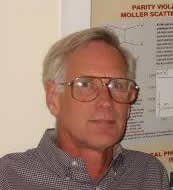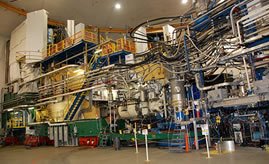SU physicist’s work with quarks may resolve unanswered questions about universe
Paul Souder gives new meaning to Standard Model of particle physics

A physicist in Syracuse University’s College of Arts and Sciences has helped determine that colliding quarks and electrons “know” the difference between left and right. His discovery may provide fresh insights into the Standard Model of particle physics and resolve unanswered questions about the nature and origins of the universe.
SU Professor Paul Souder is part of a nationwide research team that has been working at the U.S. Department of Energy's Thomas Jefferson National Accelerator Facility (Jefferson Lab) in Newport News, Va. Their findings are the subject of an article this week in the journal Nature (Nature Publishing Group, 2014).
“Since the discovery of quarks [the building blocks of protons and neutrons], scientists have been exploiting their symmetries to study their intrinsic properties and to uncover what those properties reveal about the laws that govern them,” says Souder, a pioneer in experimental medium-energy particle physics. “At Jefferson Lab, we’ve been able to study a rare instance of symmetry breaking in electron-quark scattering. This has set new limits for the energies we’d need to access to peer beyond the Standard Model.”
What is remarkable about the experiment, says Alan Middleton, professor and chair of physics at SU, is that it marks the first time scientists have witnessed this type of parity violation.
“These measurements show that when electrons and quarks collide, there is a non-zero difference between left-handed and right-handed collisions,” he says. “Paul and his team saw this by looking at 170 billion electrons, after they had collided with an atomic nucleus. … Before, [the difference] had been lost in the noise.”
Souder’s experiment has probed properties of the mirror symmetry of quarks. In mirror symmetry, the characteristics of an object remain the same, even if that object is flipped, as though it were reflected in a mirror. Classic examples include the matching wings on a butterfly, the repeating six-point patterns of a snowflake, and the smallest building blocks of matter.
The mirror symmetry of quarks may be studied via their interactions with other particles through fundamental forces.
“Three of the four forces that mediate the interactions of quarks with other particles—gravity, electromagnetism and the strong force—are mirror-symmetric,” says Souder, a recipient of the 2013 Outstanding Nuclear Physicist Award from Jefferson Science Associates, which manages Jefferson Lab. “The fourth force, the weak one, is not mirror-symmetric. This means that the intrinsic characteristics of quarks that determine how they interact through the weak force are different from, say, the electric charge for the electromagnetic force, the color charge for the strong force, or the mass for gravity.”
Souder and his colleagues measured the breaking of the mirror symmetry of quarks through a process called deep-inelastic scattering, in which a beam of electrons was shot inside an atomic nucleus to break it apart.
Xiaochao Zheng, associate professor of physics at the University of Virginia and the project’s spokesperson, says that the team noticed a difference, or an asymmetry, in the number of electrons that interacted with the quarks in the nuclei, when they were spinning in one direction versus the other.
“This asymmetry is due to the weak force between the electron and a quark in the target,” she says. “The weak force experienced by quarks has two components. One is analogous to electric charge and has been measured well in previous experiments. The other component, related to the spin of the quark, has been isolated for the first time in the Jefferson Lab experiment.”

The experiment was funded by the Department of Energy, the National Science Foundation, and the Jefferson Memorial Trust, with additional support from the researchers’ home institutions. Nearly 100 researchers from more than 30 institutions collaborated on the experiment, involving Jefferson Lab and the Argonne National Laboratory in Illinois.
SU’s Department of Physics has been educating students and carrying out research for more than 125 years. Graduate and undergraduate opportunities are available in fields ranging from biological and condensed matter physics, to cosmology and particle physics, to gravitational wave detection and astrophysics.
Media Contact
Rob Enslin
